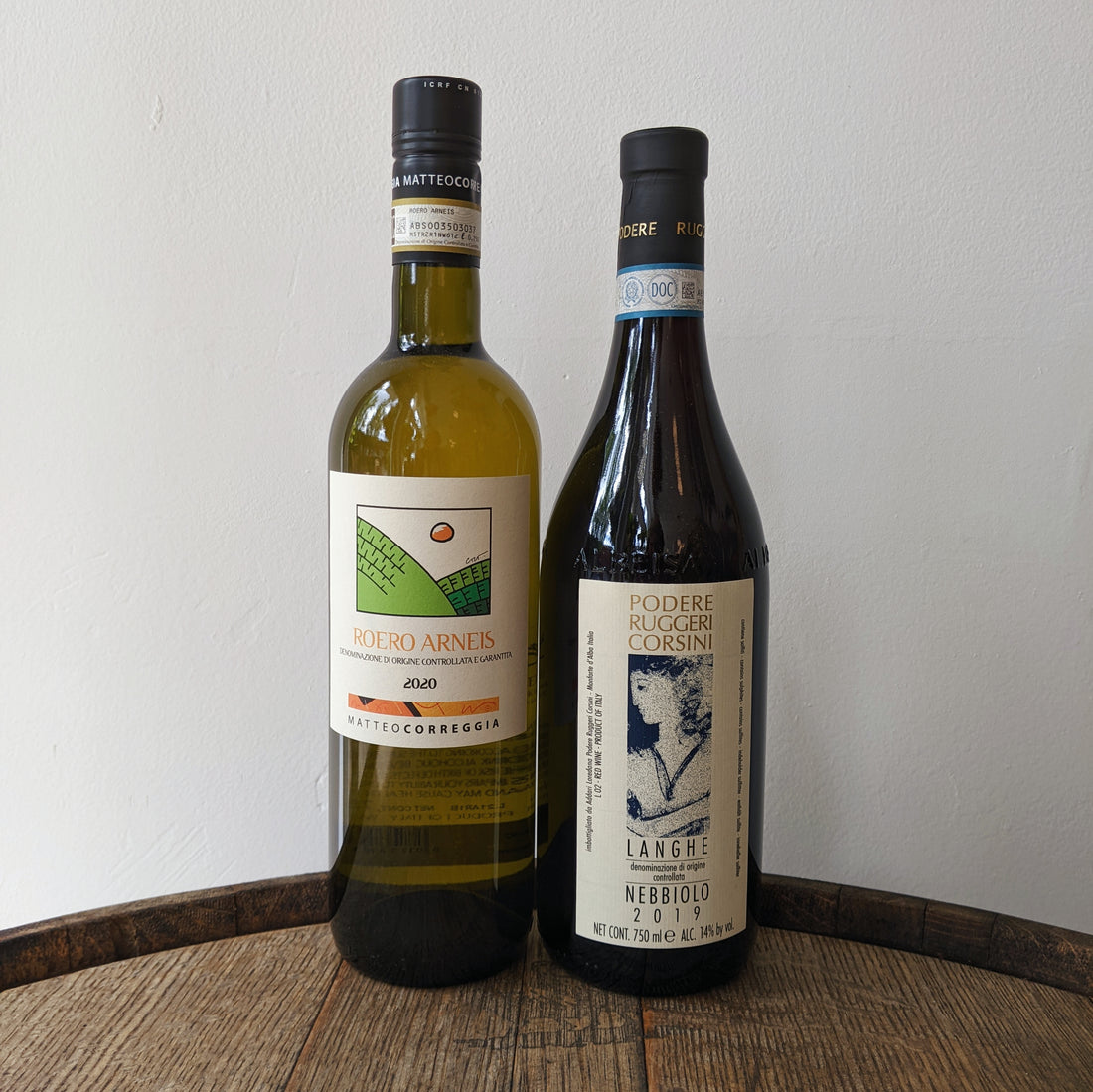
June 2022 - Galicia, Spain
June 2022
Galicia, Spain
Featuring:
Pablo Padín, ‘Segrel’ Albariño, Rias Baixas 2020
Vía Arx́entea, ‘Tinto’ Mencia, Monterrei 2019
Northern Spain’s Galicia region can evoke different emotions and reference points for many different people. For pilgrims centuries-over, it is the ultimate stop of the fabled Camino de Santiago. For surfers, it is one of the most wild and rugged destinations in the North Atlantic. For gourmands, it is a source of crispy white wines and delicious seafood. And for many, there’s absolutely no association at all. But that changes today!
Looking at a map of Spain and Portugal, Galicia is the square-ish region directly north of Portugal. With half of its border being coastline, there’s a strong association with the ocean. This is not the Spain of paella, tourist-flecked beaches, and dry arid highlands. Galicia is green. And wet. And produces a lot of timber. And has a number of highly productive ports and factories. It kind of sounds like Northern Oregon. But Galicia, and its gallego residents, is still quintessentially Spanish.
The wines of Galicia are mostly what you’d imagine from a cooler, maritime region, but there are some outliers in the south-east of the region, as the climate trends more continental. Most well known of the sub-regions would be Rias Baixas (“lower rivers” after the 6+ rivers along the Atlantic Coast). Here, Albariño is the principal variety. The wines are generally higher acid, mineral-driven, with notes of lemon zest, melon, grapefruit, and a pleasing saltiness. These are great summertime whites and perfect for seafood pairings, especially if you have tinned conservas from the region, or fresh octopus or mussels to marinate in white wine, paprika, and lemon.
Within Rias Baixas, there are 5 sub-zones that all showcase different microclimates and produce subtly different wines. While Albariño represents 96% of the plantings in the region, there are 13 other grape varieties permitted. Another interesting tid-bit, many of the vineyards will have large slabs of granite (parras) sticking upwards out of the ground. Due to the abundance of this stone in the area as well as the cold, humid climate, many have employed the stones to create complex pergola training systems. These entail the vines being trained vertically above head height before they are sprawled out laterally, creating a large canopy with plenty of room for airflow between the vines.
Rias Baixas starts just south of Santiago de Compostela, the cultural capital of the region, and continues all the way to the border with Portugal (where, in a seamless transition, Vinho Verde and Alvarinho take over, producing similar wines). However, if you turn inland and follow the Minho River east up into the Galician Massif, you’ll eventually reach the highly mountainous regions of Ribeiro, Ribeira Sacra, and Valledoras. While these regions are nowhere near as hot and arid as the interior of Spain, they are considerably drier than the coastal regions and capable of ripening fuller-bodied reds and whites. Directly south of Ribeira Sacra, along the Portuguese border, you’ll find the tiny region of Monterrei. Here, legend has it that some families own property split between both Spain and Portugal, and don’t really follow the modern borders when making and labeling their wine. Who’s to say if that bottle of Spanish red is really from Spain after all?
You’ll see many similar varieties in these regions, and most will be largely foreign to the first time eye. But fear not, amongst the seas of native grapes (Merenzao, Brancellao, Sousón Caíños Tinto, Treixadura, and Garnacha Tintorera - to name a few), there are some familiar faces (Tempranillo, Godello, and Mencia). Of these, Menica is probably the most important. This is the most prolifically grown across the four regions and becoming a hallmark spanish red in its own right. While the typical Spanish reds from regions such as Rioja or Priorat trend towards big and monstrous, full-bodied, rich, and oak-laden, the Mencia wines from these four regions (plus Bierzo, next door in Castilla y Leon) practice restraint and tension. I often compare Mencia to Nebbiolo - high acid, high tannin, light body and an intensely floral nose. It is one of the grapes to watch and a great way to check all the boxes of value, complexity, and ageability.
Pablo Padín, ‘Segrel’ Albariño, Rias Baixas 2020
I always have trouble finding a truly value-minded Rias Baixas. While there is plenty of decent, cheap, sub-$10 wine from the area (and even more from neighboring Vinho Verde), it’s hard to find a stunning mid-range bottle. It’s true that some of the tip-top producers are only $30-40 a bottle retail (much lower ceiling than White Burgundy, which many people draw comparisons to), but that can still price many people out for daily drinkers (myself included). So to me, finding a $20ish Albarino in Oregon has been a year-long quest. Enter Segrel from Pablo Padín.
This wine is a simple yet finely crafted white from the Val do Salnes subzone of Rias Baixas. A lot of the finest producers come from this area and I like to think of it as the heart of the region. Point in case, this sub-region is home of the family that really pioneered ‘quality’ albariño, the Mendez family (of Do Ferreiro, which we carry). The wine of Pablo Padin is pergola-grown and hand picked, then given a light cold-soak on the skins (to release aromatics) before gentle pressing and fermentation in stainless steel. Aged for only 6 months and never seeing a lick of oak, this is as pure and focused as you get for Albariño. I hope to be drinking it all summer.
Vía Arx́entea, ‘Tinto’ Mencia, Monterrei 2019
Gallegos are intensely proud of their unique culture and long history. It’s no surprise that Manuel Guerra Justo named his winery Vía Arx́entea after the Camino di Santiago (often called ‘the Silver Road’ over the centuries). While many think of the Camino as starting in the Pyrenees Mountains and crossing Spain East to West, that is just one popular path. The Camino is actually all roads to the Cathedral of Santiago de Compostela (where it is rumored Saint James, an apostle, is buried). Traditionally, one of these roads coming from southern Spain, near the Strait of Gibraltar, would actually pass right through Monterrei before once again turning north to make the final leg to Santiago.
Somewhere along this ‘silver road’ there is a small 4 hectare property and winery that makes two wines, one white of Godello and Treixadura, and one red, of Mencia. This red from Vía Arx́entea is a bright and perfumed expression of Mencia, with notes of pomegranate, cherry, mint, vanilla and a bit of savory/umami balsamic character. The wine is entirely made in stainless steel and intentionally released young. While Mencia can be a touch gritty in its youth (again, drawing comparisons to Nebbiolo), it is also much more floral and delicately perfumed when young. Given time to age, that umami character will present itself more and more and the red cherry fruit will fade away.
